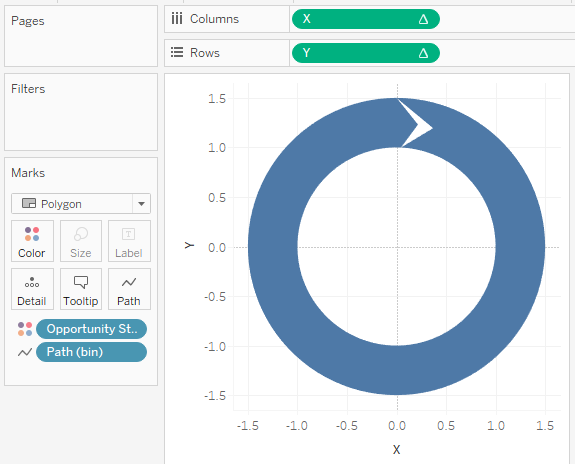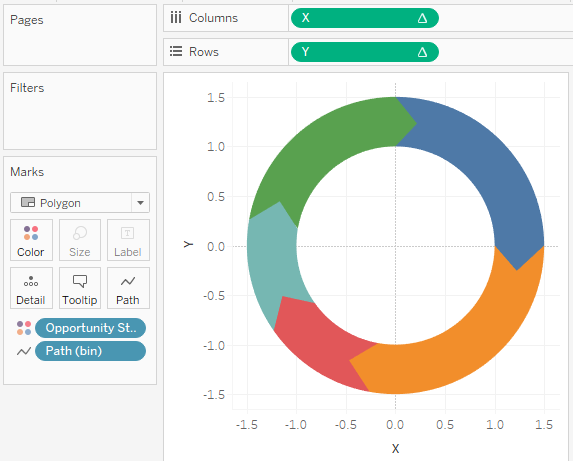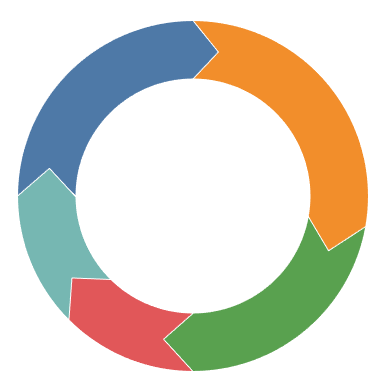How to Draw a Circle in Tableau

I do dearest cartoon visualizations in Tableau and every time I see something interesting on a website, PowerPoint deck, magazine or any other presentation tool, the commencement matter that comes to heed is can I create this in Tableau? This was my thoughts when I saw Process Circles in PowerPoint and this step-by-stride tutorial volition go through the process of creating a procedure circumvolve to visualise the number of opportunities at each phase of an Opportunity Pipeline, so permit united states of america get started.
Note: Every bit always never choose a data visualisation type and effort to fit your data into it, instead, empathise your data and choose the best visualization for your data consumers.
Data
Load the following data into Tableau Desktop / Public.
| Opportunity Stage | Path | Number of Opportunities |
| Initial Contact | 1 | 100 |
| Initial Contact | 204 | 100 |
| Qualification | 1 | fourscore |
| Qualification | 204 | 80 |
| Meeting | ane | 45 |
| Coming together | 204 | 45 |
| Proposal | 1 | 45 |
| Proposal | 204 | 45 |
| Close | one | xc |
| Close | 204 | 90 |
Notation: we demand ii records for each phase every bit we are going to be drawing polygons and using densification to get more points on our canvas.
Calculated Fields
With our data set loaded into Tableau, we are going to create the post-obit Calculated Fields and Bins:
Path (bin)
- Right click onPath, go toCreate and selectBins…
- In the Edit Bins dialogue window:
- PrepareNew field proper name toPath (bin).
- SetSize of bins to1.
- ClickOk.
Index
INDEX()-1 TC_Stage Number
WINDOW_MAX(MAX([Number])) TC_Total Number
WINDOW_SUM(SUM([Number]))/2 TC_Step Size
[TC_Stage Number]/[TC_Total Number]*iii.vi TC_Starting Point
(RUNNING_SUM([TC_Stage Number])-[TC_Stage Number]) *(360/[TC_Total Number]) X
IF [Index] = 0 THEN SIN(((([Alphabetize]*[TC_Step Size]) +[TC_Starting Betoken])+ten)*PI()/180)*1.25 ELSEIF [Index] <= 101 So SIN(((([Index]*[TC_Step Size]) +[TC_Starting Bespeak])-ane)*PI()/180) ELSEIF [Index] = 102 THEN SIN(((([Index]*[TC_Step Size]) +[TC_Starting Point])+10)*PI()/180)*i.25 ELSE SIN((((203-[Index])*[TC_Step Size]) +[TC_Starting Point])*PI()/180)*1.5 Cease Y
IF [Alphabetize] = 0 And so COS(((([Index]*[TC_Step Size]) +[TC_Starting Point])+10)*PI()/180)*1.25 ELSEIF [Alphabetize] <= 101 And then COS(((([Alphabetize]*[TC_Step Size]) +[TC_Starting Point])-1)*PI()/180) ELSEIF [Alphabetize] = 102 THEN COS(((([Index]*[TC_Step Size]) +[TC_Starting Betoken])+ten)*PI()/180)*1.25 ELSE COS((((203-[Index])*[TC_Step Size]) +[TC_Starting Indicate])*PI()/180)*1.v END Allow united states get through Y because it actually does deserve our attention:
- We have iv different points to depict:
-
Index is 0 which is the back of the arrow indent. -
Index is 102 which is the tip of the arrow. -
Alphabetize is betwixt 0 and 102 which draws the inside line. -
Alphabetize is greater than 102 which depict the outside line.
-
- Multiplying the degrees past PI() then dividing by 180 converts degrees to Radians.
- Nosotros multiply past the Step Size to ensure that nosotros size our arrows correctly.
- We add together the starting indicate so that our arrows align with each other.
Then now that we have created a lot of Calculated fields, nosotros will now put this together into a Worksheet.
Worksheet
We will now build our worksheet:
- Modify the Marker Type to Polygon.
- Drag Path (bin) onto Columns.
- Correct-click on the pill and make sure that Show Missing Values is selected.
- Drag this object onto thePath Mark.
- Drag Opportunity Stage onto Color.
- Drag Ten onto Columns.
- Right-click on Ten, go to
Compute Using and select Path (bin).
- Right-click on Ten, go to
- Drag Y onto Rows.
- Right-click on Y, go to
Compute Using and select Path (bin).
- Right-click on Y, go to
You should now see something like the post-obit:

No need to panic, we but need to conform the Tabular array Calculations, and so now let united states:
- Right-click on the X object in Columns and select Edit Tabular array Calculations.
- In Nested Calculations select TC_Stage Number:
- In
Compute Using select Specific Dimensions. - Tick Opportunity Stages and Path (bin) and ensure that Opportunity Stages is on pinnacle.
-
In At the level select Deepest. - In Restarting every select Opportunity Stages.
- In
- InNested Calculations selectTC_Total Number:
- In
Compute Using selectSpecific Dimensions. - TickOpportunity StagesandPath (bin) and ensure thatOpportunity Stages is on tiptop.
-
In At the level selectDeepest. - InRestarting every selectNone.
- In
- InNested Calculations selectTC_Starting Betoken:
- In
Compute Using selectSpecific Dimensions. - TickOpportunity Stagesonly.
- In
- In Nested Calculations select TC_Stage Number:
- Correct-click on theY object inColumnsand selectEdit Table Calculations.
- InNested Calculations selectTC_Stage Number:
- In
Compute Using selectSpecific Dimensions. - TickOpportunity StagesandPath (bin) and ensure thatOpportunity Stages is on acme.
-
In At the level selectDeepest. - InRestarting every selectOpportunity Stages.
- In
- InNested Calculations selectTC_Total Number:
- In
Compute Using selectSpecific Dimensions. - TickOpportunity StagesandPath (bin) and ensure thatOpportunity Stages is on top.
-
In At the level selectDeepest. - InRestarting every selectNone.
- In
- InNested Calculations selectTC_Starting Point:
- In
Compute Using selectSpecific Dimensions. - TickOpportunity Stagessimply.
- In
- InNested Calculations selectTC_Stage Number:
If all has gone well you should at present run across the following:

Now we need to adjust the visualisation by:
- Editing tooltips.
- Editing colours and adding a white edge.
- Editing fonts.
- Removing gridlines.
- Hiding headers.
- Sort the Opportunity manually to be:
- Initial Contact
- Qualification
- Meeting
- Proposal
- Shut
And you should and then end up with something similar the following:

and boom, that is a wrap, nosotros have gone through and drawn ourselves an Interactive and Dynamic Process Chart, seriously, elevate Opportunity Stage onto the filter and take a play.
You tin see and interact with my visualisation on Tableau Public
Summary
I promise y'all all enjoyed this article as much equally I enjoyed writing it, if so, delight do share this article with young man Tableau addicts and spread the love. Do let me know if you experienced any issues recreating this Visualisation, and as e'er, please leave a comment below or reach out to me on Twitter @Tableau_Magic.
If y'all like our work, practise consider supporting us on Patreon, and for supporting us, we will give y'all early admission to tutorials, exclusive videos, as well as access to current and future courses on Udemy:
- Patreon: https://www.patreon.com/tableaumagic
Also, do be sure to check out our various courses:
- Creating Bespoke Information Visualizations (Udemy)
- Introduction to Tableau (Online Teacher-Led)
- Advanced Calculations (Online Instructor-Led)
- Creating Bespoke Data Visualizations (Online Instructor-Led)
Source: https://tableau.toanhoang.com/drawing-process-circles-in-tableau/
Post a Comment for "How to Draw a Circle in Tableau"